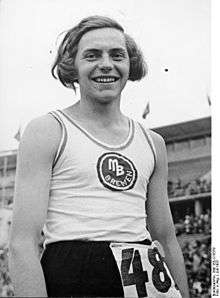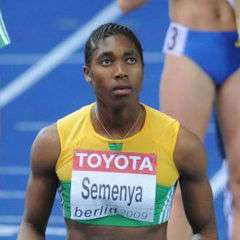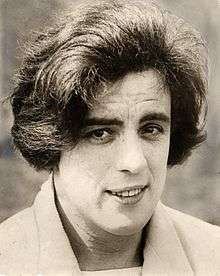Sex verification in sports
Sex verification in sports (also known as gender verification, or loosely as gender determination or a sex test) is the issue of verifying the eligibility of an athlete to compete in a sporting event that is limited to a single sex. The issue has arisen multiple times in the Olympic games and other sporting competitions where it has been alleged that male athletes attempted to compete as women, or that a woman has an intersex condition giving an alleged unfair advantage.
The first mandatory sex test issued by the IAAF for woman athletes was in July 1950 in the month before the European Championships in Belgium. All athletes were tested in their own countries.[1] Sex testing at the games began at the 1966 European Athletics Championships in response to suspicion that several of the best women athletes from the Soviet Union and Eastern Europe were actually men.[2] At the Olympics, testing was introduced in 1968.
Initially, sex verification took the form of physical examinations. It subsequently evolved into chromosome testing, and later testosterone testing. It is not always a simple case of checking for XX vs. XY chromosomes, or sex hormone levels, to determine whether an athlete is unambiguously a woman or a man. Fetuses start out as undifferentiated, and the Y chromosome turns on a variety of hormones that differentiate the baby as a male. Sometimes this does not occur, and people with two X chromosomes can develop hormonally or phenotypically as a male, and people with an X and a Y can develop hormonally or phenotypically as a female.[3]
Reports have shown how elite women athletes have been humiliated, excluded, and suffered human rights violations as a result of sex verification testing.[4][5][6] Such cases have included female genital mutilation and sterilization.[6]
History
Physical examinations
United States Olympic Committee president Avery Brundage requested, during or shortly after the 1936 Summer Olympics in Berlin, that a system be established to examine female athletes. According to a Time magazine article about hermaphrodites, Brundage felt the need to clarify "sex ambiguities" after observing the performance of Czechoslovak runner and jumper Zdeňka Koubková and English shotputter and javelin thrower Mary Edith Louise Weston. Both individuals later had sex change surgery and legally changed their names, to Zdeněk Koubek and Mark Weston, respectively.[7]
Sex verification tests began in the 1960s, using physical examinations.[8] Initially, women athletes "were asked to parade nude before a panel of doctors".[8] For a period of time these tests were mandatory for female athletes, due to fears that male athletes would pose as female athletes and have an unfair advantage over their competitors.[8]
Chromosome testing
Chromosome testing was introduced by the International Olympic Committee in 1968, at the Mexico City Olympics.[8] This tested for the presence of the SRY gene, which is found on the Y-chromosome, and was designed to identify males potentially disguised as females. This method of testing was later abolished, as it was shown to be inconclusive in identifying maleness.[9]
The International Association of Athletics Federations ceased sex screening for all athletes in 1992,[10] but retained the option of assessing the sex of a participant should suspicions arise. A resolution was passed at the 1996 International Olympic Committee (IOC) World Conference on Women and Health "to discontinue the current process of gender verification during the Olympic Games." The International Olympic Committee's board voted to discontinue the practice in June 1999.[11] Chromosome testing was last performed at the Atlanta Olympic Games in 1996.
The practice of chromosome testing came under scrutiny from those who feel that the testing was humiliating, socially insensitive, and not entirely accurate or effective. The testing is especially difficult in the case of people who could be considered intersex. Genetic differences can allow a person to have a male genetic make-up and female anatomy or body chemistry. In the Journal of the American Medical Association, Simpson, Ljungqvist and others stated,
Gender verification tests are difficult, expensive, and potentially inaccurate. Furthermore, these tests fail to exclude all potential impostors (eg, some 46,XX males), are discriminatory against women with disorders of sexual development, and may have shattering consequences for athletes who 'fail' a test...
Gender verification has long been criticized by geneticists, endocrinologists, and others in the medical community. One major problem was unfairly excluding women who had a birth defect involving gonads and external genitalia (i.e., male pseudohermaphroditism). ...
A second problem is that only women, not men, were subjected to Gender verification testing. Systematic follow-up was rarely available for athletes "failing" the test, which often was performed under very public circumstances. Follow-up was crucial because the subjects were not male impostors, but intersexed individuals.[12]
Hormone testing
In August 2009, South African athlete Caster Semenya was subjected to mandatory sex verification testing.[13] In the wake of the Semenya case, testosterone testing was introduced to identify cases where testosterone levels were elevated above an arbitrary level, termed hyperandrogenism, with national Olympics committees tasked by the IOC to "actively investigate any perceived deviation in sex characteristics".[4][8]
In football, FIFA's current gender verification policy dates to May 30, 2011 [14][15] In June 2012, in advance of the 2012 Summer Olympics, the IOC released IOC Regulations on Female Hyperandrogenism, which addressed cases of female hyperandrogenism. The regulation includes the statement, "Nothing in these Regulations is intended to make any determination of sex. Instead, these Regulations are designed to identify circumstances in which a particular athlete will not be eligible (by reason of hormonal characteristics) to participate in 2012 OG Competitions in the female category. In the event that the athlete has been declared ineligible to compete in the female category, the athlete may be eligible to compete as a male athlete, if the athlete qualifies for the male event of the sport."[16]
As with previous forms of sex testing, testosterone testing has been regarded as humiliating, unnecessary and discriminatory.[4][17] Katrina Karkazis, Rebecca Jordan-Young, Georgiann Davis and Silvia Camporesi argued that the new IAAF policies on hyperandrogenism in female athletes will not protect against breaches of privacy, will require athletes to undergo unnecessary treatment in order to compete, and will intensify "gender policing". They recommend that athletes be able to compete in accordance with their legal gender.[18][19]
In 2013, it was reported by Patrick Fénichel, Stéphane Bermon and others that four elite female athletes from developing countries were subjected to partial clitoridectomies and gonadectomies (sterilization) after testosterone testing revealed that they had an intersex condition.[4][20] Members of the same clinical hormone evaluation team report there is no evidence that innate hyperandrogenism in elite women athletes confers an advantage in sport.[21] The case has been criticized as showing vulnerability of women athletes to unnecessary medical interventions under duress, with no evidence of cheating and no evidence of athletic advantage.[4][22]
Policies on hyperandrogenism were suspended following the case of Dutee Chand v. Athletics Federation of India (AFI) & The International Association of Athletics Federations, in the Court of Arbitration for Sport, decided in July 2015.[23] Chand had been dropped from the 2014 Commonwealth Games at the last minute after the Athletic Federation of India stated that hyperandrogenism made her ineligible to compete as a female athlete.[24] The ruling found that there was insufficient evidence that testosterone increased female athletic performance. In doing so the court suspended the practice of hyperandrogenism regulation used by the IAAF. The practice will be declared void if the organization fails to present better evidence by July 2017.[25]
In November 2015, the IOC held a meeting to address both its hyperandrogenism and transgender policies. In regards to hyperadrogenism in female athletes, the IOC encouraged reinstatement of the IAAF policies suspended by the Court of Arbitration for Sport. It also repeated an earlier policy statement that, to "avoid discrimination, if not eligible for female competition the athlete should be eligible to compete in male competition".[26][27] In February 2016, it was made known that the IOC would not introduce its own policies that would impose a maximum testosterone level for the 2016 Summer Olympics.[28]
In April 2016, the United Nations Special Rapporteur on health, Dainius Pūras, criticized current and historic sex verification policies, describing how "a number of athletes have undergone gonadectomy (removal of reproductive organs) and partial cliteroidectomy (a form of female genital mutilation) in the absence of symptoms or health issues warranting those procedures."[6]
Sporting organizations must implement policies in accordance with human rights norms and refrain from introducing policies that force, coerce or otherwise pressure women athletes into undergoing unnecessary, irreversible and harmful medical procedures in order to participate as women in competitive sport. States should also adopt legislation incorporating international human rights standards to protect the rights of intersex persons at all levels of sport, given that they frequently report bullying and discriminatory behaviour, and should take steps to protect the health rights of intersex women in their jurisdiction from interference by third parties.[6]
The cases of Dutee Chand and Caster Semenya were widely reported during the 2016 Rio Olympics.[29][30] Immediately preceding the games, Genel, Simpson and de la Chapelle were again published in the Journal of the American Medical Association starting "One of the fundamental recommendations published almost 25 years ago ... that athletes born with a disorder of sex development and raised as females be allowed to compete as women remains appropriate":
with the passage of time and the recurring public spectacle of young women ... having their underlying biology indiscriminately scrutinized in the world media, it has become evident that the hyperandrogenism policies are no more salutary than earlier attempts to define sharp sex boundaries.[31]
Sex verification in men
Sex verification is not conducted on male athletes, those competing in the male category, and little data is available on their chromosomes or hormone profiles. However, a post-competition study of 693 elite athletes by Healy et al, published in 2014, found significant sex differences in many variables. The authors found that:
16.5% of men had low testosterone levels, whereas 13.7% of women had high levels with complete overlap between the sexes.[32]
Using this data, Scientific American estimated that "almost 2 percent" of male competitors had testosterone levels in the typical female range.[33] The study authors also stated that average lean body mass differences might account for performance differences between sexes.[32]
Notable cases
20th century
- Perhaps the earliest known case is that of Stanisława Walasiewicz (aka Stella Walsh), a Polish athlete who won a gold medal in the women's 100 m at the 1932 Summer Olympics in Los Angeles, but who after her death in 1980 was discovered to have had partially developed male genitalia.[34]
- Before the advent of sexual verification tests, German athlete Dora Ratjen competed in the 1936 Olympic Games in Berlin and placed fourth in the women's high jump. She later competed and set a world record for the women's high jump at the 1938 European Championships before tests by the German police concluded that Ratjen was a man. Ratjen was likely an intersex individual, based on the physician's description who conducted the examination. Though raised as a girl, Ratjen later took the name Heinrich Ratjen following an official registry change.[35]
- The Dutch sprinter Foekje Dillema was expelled from the 1950 national team after she refused a mandatory sex test in July 1950; later investigations revealed a Y-chromosome in her body cells, and the analysis showed that she probably was a 46,XX/46,XY mosaic female.[36]
- Sisters Tamara and Irina Press won five track and field Olympic gold medals for the Soviet Union and set 26 world records in the 1960s. They ended their careers before the introduction of gender testing in 1966. Although both sisters were accused of being men or hermaphrodites, there is no evidence of an intersex condition in these cases.[2]
- Polish athlete Ewa Kłobukowska, who won the gold medal in women's 4 × 100 m relay and the bronze medal in women's 100 m sprint at the 1964 Summer Olympics in Tokyo, is the first athlete to fail a gender test in 1967. She was found to have the rare genetic condition of XX/XXY mosaicism and was banned from competing in Olympic and professional sports.[37]
- In 1967 the IOC disqualified Erika Schinegger, the 1966 female world champion in downhill skiing, from the 1968 Winter Games in Grenoble after determining Schinegger had internal male sex organs. Schinegger later transitioned to a male, Erik.
- In 1986, Spanish hurdler Maria José Martínez-Patiño was dismissed and publicly shamed after failing a chromosomal test.[5][38]
 Stanisława Walasiewicz (aka Stella Walsh)
Stanisława Walasiewicz (aka Stella Walsh)

 Sisters Tamara and Irina Press
Sisters Tamara and Irina Press Erik Schinegger in 2014
Erik Schinegger in 2014
21st century

- Indian middle-distance runner Santhi Soundarajan, who won the silver medal in 800 m at the 2006 Asian Games in Doha, Qatar, failed the sex verification test and was stripped of her medal.
- South African runner Caster Semenya won the 800 meters at the 2009 World Championships in Athletics in Berlin. The International Association of Athletics Federations (IAAF), track and field's governing body, confirmed that Semenya had agreed to a sex-testing process that began in South Africa and would continue in Germany. On July 6, 2010, the IAAF confirmed that Semenya was cleared to continue competing as a woman. The results of the gender testing were never officially released for privacy reasons.[39]
- After female Indian track athlete Pinki Pramanik was accused by a female roommate of rape and later charged, she was gender tested and declared a male although she and other medical experts dispute the claims.[40]
- Four unnamed women athletes from developing countries were subjected to gonadectomies (a form of sterilization) and female genital mutilation as part of a process to enable them to compete.[4][6] The female athletes were discovered to have an intersex trait during testosterone testing; the case was first published in 2013.[20]
- Dutee Chand was dropped from the 2014 Commonwealth Games at the last minute after the Athletic Federation of India stated that hyperandrogenism made her ineligible to compete as a female athlete.[24] Chand took a case to the Court of Arbitration for Sport and won an interim judgment in mid-2015.[23] In February 2016, it was made known that the IOC would not impose a maximum testosterone level for the 2016 Summer Olympics.[28] In June 2016, Chand qualified to compete in the 100 metre race at the Summer Olympics.[41]
Transgender athletes
In November 2015, the IOC held a meeting to address both its transgender and hyperandrogenism policies. In regards to transgender athletes it stated that transgender athletes cannot be excluded from an opportunity to participate in sporting competition. Transgender athletes who identified themselves as female, would be allowed to compete in that category as long as their testosterone levels were below 10 nanomoles per liter for at least 12 months prior to the competition. There would be no restrictions on transgender athletes identifying themselves as male and competing in that category.[26] The IOC stated that requiring surgical anatomical changes as a requirement for participation may be considered as a violation of notions of human rights.[42]
Notable cases
- Professional tennis player Renée Richards, a transsexual woman, was barred from playing as a woman at the 1976 US Open unless she submitted to chromosome testing. She sued the United States Tennis Association and in 1977 won the right to play as a woman without submitting to testing.[43]
See also
References
- ↑ Dohle, Max; Ettema, Dick (2012). "Foekje Dillema". Retrieved 2016-05-28.
- 1 2 R. Peel, "Eve’s Rib - Searching for the Biological Roots of Sex Differences", Crown Publishers, New York City, 1994, ISBN 0-517-59298-3
- ↑ Dreger, Alice (August 21, 2009). "Where's the Rulebook for Sex Verification?". New York Times. Retrieved 2009-08-21.
- 1 2 3 4 5 6 Jordan-Young, R. M.; Sonksen, P. H.; Karkazis, K. (April 2014). "Sex, health, and athletes". BMJ. 348 (apr28 9): –2926–g2926. doi:10.1136/bmj.g2926. ISSN 1756-1833. Retrieved 2016-05-21.
- 1 2 Martínez-Patiño, Maria José (December 2005). "Personal Account: A woman Tried and Tested". The Lancet. 366: 366–538. doi:10.1016/s0140-6736(05)67841-5.
- 1 2 3 4 5 Pūras, Dainius; Special Rapporteur on the right of everyone to the enjoyment of the highest attainable standard of physical and mental health (April 4, 2016), Sport and healthy lifestyles and the right to health. Report A/HRC/32/33, United Nations
- ↑ "Change of Sex" 24 August 1936 Time
- 1 2 3 4 5 "A Lab is Set to Test the Gender of Some Female Athletes.". New York Times. 30 July 2008.
- ↑ "Olympic Gender Testing".
- ↑ Simpson JL, Ljungqvist A, de la Chapelle A, et al. (November 1993). "Gender verification in competitive sports". Sports Medicine. 16 (5): 305–15. doi:10.2165/00007256-199316050-00002. PMID 8272686.
- ↑ Genel M (2000). "Gender verification no more?". Medscape Women's Health. 5 (3): E2. PMID 11109043.
- ↑ Simpson J; Ljungqvist A; Ferguson-Smith MA; de la Chapelle, A; Elsas, L J; Ehrhardt, A A; Genel, M; Ferris, E A; Carlson, A (September 2000). "Gender verification in the Olympics". JAMA. 284 (12): 1568–9. doi:10.1001/jama.284.12.1568. PMID 11000653.
- ↑ "Semenya told to take gender test". BBC Sport. 19 August 2009. Retrieved 19 August 2009.
- ↑ "FIFA issues gender verification regulations for all competitions". FIFA. 8 Jun 2011.
- ↑ "Regulations. FIFA Gender Verification" (PDF). FIFA. June 2011.
- ↑ "IOC Regulations on Female Hyperandrogenism" (PDF). International Olympic Committee. June 22, 2012. Retrieved 2012-08-09.
- ↑ Karkazis, Katrina; Jordan-Young, Rebecca (May 2015). "Debating a testosterone "sex gap"". Science. 348 (6237): 858–860. doi:10.1126/science.aab1057. PMID 25999490. Retrieved 2016-05-28.
- ↑ Karkazis, Katrina; Jordan-Young, Rebecca; Davis, Georgiann; Camporesi, Silvia (July 2012). "Out of Bounds? A Critique of the New Policies on Hyperandrogenism in Elite Female Athletes". The American Journal of Bioethics. 12 (7): 3–16. doi:10.1080/15265161.2012.680533. ISSN 1526-5161. PMID 22694023. Retrieved 2016-05-21.
- ↑ Jordan-Young, Rebecca; Karkazis, Katrina (June 17, 2012), "You Say You're a Woman? That Should Be Enough", New York Times, retrieved 2012-08-09
- 1 2 Fénichel, Patrick; Paris, Françoise; Philibert, Pascal; Hiéronimus, Sylvie; Gaspari, Laura; Kurzenne, Jean-Yves; Chevallier, Patrick; Bermon, Stéphane; Chevalier, Nicolas; Sultan, Charles (June 2013). "Molecular Diagnosis of 5α-Reductase Deficiency in 4 Elite Young Female Athletes Through Hormonal Screening for Hyperandrogenism". The Journal of Clinical Endocrinology & Metabolism. 98 (6): –1055–E1059. doi:10.1210/jc.2012-3893. ISSN 0021-972X. Retrieved 2016-05-28.
- ↑ Bermon, Stéphane; Garnier, Pierre Yves; Lindén Hirschberg, Angelica; Robinson, Neil; Giraud, Sylvain; Nicoli, Raul; Baume, Norbert; Saugy, Martial; Fénichel, Patrick; Bruce, Stephen J.; Henry, Hugues; Dollé, Gabriel; Ritzen, Martin (August 2014). "Serum Androgen Levels in Elite Female Athletes". The Journal of Clinical Endocrinology & Metabolism. 99 (11): –2014–1391. doi:10.1210/jc.2014-1391. ISSN 0021-972X. Retrieved 2016-05-28.
- ↑ "Women athletes forced to undergo clitorectomies to compete". Organisation Intersex International Australia. 28 April 2014. Retrieved 2016-05-28.
- 1 2 Court of Arbitration for Sport (July 2015). CAS 2014/A/3759 Dutee Chand v. Athletics Federation of India (AFI) & The International Association of Athletics Federations (IAAF) (PDF). Court of Arbitration for Sport.
- 1 2 Slater, Matt (28 July 2015). "Sport & gender: A history of bad science & 'biological racism'". BBC Sport. Retrieved 28 July 2015.
- ↑ Branch, John (27 July 2016). "Dutee Chand, Female Sprinter With High Testosterone Level, Wins Right to Compete". The New York Times. Retrieved 22 May 2016.
The Court of Arbitration for Sport, based in Switzerland, questioned the athletic advantage of naturally high levels of testosterone in women and therefore immediately suspended the practice of 'hyperandrogenism regulation' by track and field’s governing body, the International Association of Athletics Federations. It gave the organization, known as the I.A.A.F., two years to provide more persuasive scientific evidence linking 'enhanced testosterone levels and improved athletic performance.'
- 1 2 International Olympic Committee (November 2015), IOC Consensus Meeting on Sex Reassignment and Hyperandrogenism (PDF)
- ↑ "IOC policy: no change for athletes with intersex traits". Organisation Intersex International Australia. 2 February 2016. Retrieved 2016-05-28.
- 1 2 "IOC won't introduce rules that would block Indian sprinter from Rio Games | Toronto Star". thestar.com. Archived from the original on 2016-04-05. Retrieved 2016-06-29.
- ↑ Critchley, Mark. "Fifth-placed runner behind Semenya 'feels like silver medalist' and glad she was the 'second white'". The Independent. Retrieved 23 August 2016.
- ↑ Karkazis, Katrina. "The ignorance aimed at Caster Semenya flies in the face of the Olympic spirit". The Guardian. ISSN 0261-3077. Retrieved 15 September 2016.
- ↑ Genel M; Simpson J; de la Chapelle A (August 4, 2016). "The olympic games and athletic sex assignment". JAMA. doi:10.1001/jama.2016.11850. ISSN 0098-7484.
- 1 2 Healy, M. L.; Gibney, J.; Pentecost, C.; Wheeler, M. J.; Sonksen, P. H. (August 2014). "Endocrine profiles in 693 elite athletes in the postcompetition setting". Clinical Endocrinology. 81 (2): 294–305. doi:10.1111/cen.12445. ISSN 0300-0664. PMID 24593684. Retrieved 2016-08-24.
- ↑ The Editors (August 2016). "Naturally Occurring High Testosterone Shouldn't Keep Female Athletes Out of Competition". Scientific American. Retrieved 2016-08-24.
- ↑ Klaudia Snochowska-Gonzales. "Walasiewicz była kobietą (Walasiewicz Was a Woman)". Gazeta Wyborcza (in Polish). 190 (14 August 2004): 8. Retrieved 31 May 2006.
- ↑ Berg, Stefan (15 September 2009). "How Dora the Man Competed in the Woman's High Jump". Der Spiegel. Retrieved 31 August 2010.
- ↑ Ballantyne KN, Kayser M, Grootegoed JA (June 2012). "Sex and gender issues in competitive sports: investigation of a historical case leads to a new viewpoint". British Journal of Sports Medicine. 46 (8): 614–7. doi:10.1136/bjsm.2010.082552. PMC 3375582
 . PMID 21540190.
. PMID 21540190. - ↑ Ritchie, R.; Reynard, J.; Lewis, T. (2008). "Intersex and the Olympic Games". JRSM. 101 (8): 395. doi:10.1258/jrsm.2008.080086.
- ↑ Zeigler, Cyd (7 September 2011). "Moment #27: María José Martínez-Patiño kicked off Spanish track team, titles stripped". Outsports. Retrieved 2 March 2015.
- ↑ Motshegwa, Lesogo; Gerald Imray (2010-07-06). "World champ Semenya cleared to return to track". Yahoo!. Associated Press. Retrieved 2010-07-06. Archived July 15, 2010, at the Wayback Machine.
- ↑ "Medical experts doubt Pinki Pramanik can rape". Times of India. 14 November 2012. Retrieved 15 November 2012.
- ↑ Padawer, Ruth (2016-06-28). "The Humiliating Practice of Sex-Testing Female Athletes". The New York Times. ISSN 0362-4331. Archived from the original on 2016-06-28. Retrieved 2016-06-28.
- ↑ "Exclusive: Read the Olympics' new transgender guidelines that will not mandate surgery". Outsports. Retrieved 2016-03-02.
- ↑ Amdur, Neil (August 17, 1977). "Renee Richards Ruled Eligible for U.S. Open; Ruling Makes Renee Richards Eligible to Qualify for U.S. Open". The New York Times.

